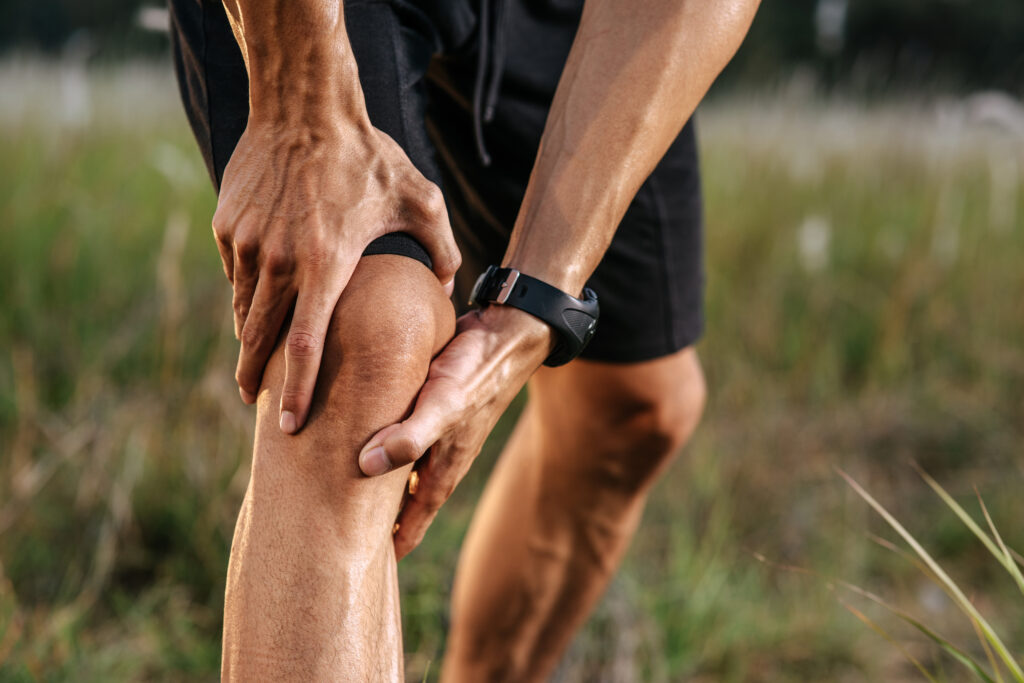If you're looking to enhance your joint flexibility and movement naturally, it's important to take into account a thorough approach that goes beyond mere stretching. By integrating strength training and mindful practices into your routine, you can create a balanced strategy that supports both flexibility and overall joint health. But the journey doesn't stop there; nutrition plays a vital role too, influencing how your joints respond to daily activities. Curious about the best techniques and habits to adopt for lasting improvement? The answers might surprise you.
Understanding Joint Flexibility
Joint flexibility refers to the range of motion in your joints, and it's essential for overall movement and physical performance. Understanding joint flexibility involves recognizing the factors that influence your range of motion. This flexibility varies from person to person, based on genetics, activity levels, and age. You might notice that some people can easily perform deep squats or touch their toes, while others struggle with these movements.
A key aspect of joint flexibility is the soft tissues around your joints, including muscles, tendons, and ligaments. When these tissues are tight or inflexible, they can limit your joint's range of motion. Regular activity, especially stretching and mobility exercises, can enhance the flexibility of these soft tissues, allowing your joints to move more freely.
Your daily habits also play a significant role in joint flexibility. If you spend long hours sitting, the muscles around your hips and lower back may become tight, affecting your flexibility. Incorporating short breaks to stretch or move throughout your day can help maintain and improve your joint range of motion.
Additionally, warm-up routines before physical activities are vital. They prepare your joints and muscles for movement, minimizing the risk of injury.
Benefits of Improved Mobility
Improved mobility can greatly enhance your physical performance, allowing you to move more freely and efficiently.
It also reduces your risk of injury by promoting better joint function and stability.
Plus, with better mobility, you'll notice improved posture alignment, which contributes to overall health and well-being.
Enhanced Physical Performance
How can enhanced mobility transform your physical performance? When you improve your joint flexibility, you're not just making it easier to move; you're releasing your body's full potential.
Enhanced mobility allows you to execute movements more fluidly and efficiently, whether you're running, lifting weights, or practicing yoga. You'll notice an immediate difference in your strength and power output, as your muscles can engage more fully during each movement.
A greater range of motion means you can perform exercises with better form, leading to more effective workouts. This efficiency can lead to quicker gains in strength and endurance, allowing you to push your limits and achieve your fitness goals.
Additionally, improved mobility can enhance your coordination and balance, making everyday activities—like climbing stairs or playing sports—easier and more enjoyable.
Ultimately, when you focus on enhancing your mobility, you're setting the stage for a more dynamic and powerful physical performance. You'll feel more agile, responsive, and capable in all your physical endeavors.
Reduced Injury Risk
With greater mobility, you're not just enhancing performance; you're also considerably reducing your risk of injury. When your joints can move freely and efficiently, your body can adapt better to the stresses of physical activities. This adaptability is essential in preventing strains, sprains, and other injuries that often arise from limited range of motion.
Improved mobility allows for smoother, more coordinated movements. When your muscles and joints work in harmony, you're less likely to overexert yourself or make awkward movements that can lead to injury. By incorporating flexibility exercises and mobility routines into your training, you're actively safeguarding your body against common athletic injuries.
In addition, enhanced mobility promotes better balance and stability. When you're able to move your joints through their full range, you can maintain control even in dynamic situations. This control is critical for activities like running, jumping, or even simply maneuvering uneven surfaces.
Ultimately, investing time in improving your mobility isn't just about performance; it's about protecting yourself. By prioritizing flexibility and movement, you're setting yourself up for longevity in your physical pursuits, minimizing the chances of setbacks caused by injury.
Better Posture Alignment
When you prioritize mobility in your training, you can experience a significant boost in your posture alignment. Improved mobility allows your muscles and joints to move more freely, which helps maintain the natural curves of your spine. This harmonious alignment reduces strain on your muscles and ligaments, making daily activities feel easier and more comfortable.
As you work on your flexibility, you'll likely notice that you stand taller and feel more confident. Engaging in exercises that enhance your mobility encourages better body awareness, allowing you to recognize when you're slouching or misaligning your posture. As a result, you can make conscious adjustments throughout your day, whether you're sitting at a desk or walking.
Better posture not only improves your appearance but also enhances your overall health. With less tension on your muscles, you can reduce fatigue and discomfort associated with poor posture, leading to increased energy levels.
Additionally, you might find that your breathing improves as your chest opens up, allowing for deeper, more efficient breaths. By committing to mobility training, you'll reap the benefits of better posture alignment, enhancing both your physical and mental well-being.
Effective Stretching Techniques
Revealing the benefits of effective stretching techniques can greatly enhance your joint flexibility and overall movement. By incorporating these strategies into your daily routine, you'll notice improvements in your range of motion and reduced stiffness.
Here are some effective stretching techniques to evaluate:
- Dynamic Stretching: This involves moving parts of your body through a full range of motion, gradually increasing reach and speed. Perfect for warming up before activities.
- Static Stretching: Hold a stretch for 15-30 seconds to lengthen muscles and improve flexibility. It's most effective after your workouts when your muscles are warm.
- Ballistic Stretching: This technique uses momentum to push your body beyond its normal range of motion. While it can be beneficial for some athletes, it's important to approach it with caution to avoid injury.
- Proprioceptive Neuromuscular Facilitation (PNF): A combination of stretching and contracting your muscles, PNF is highly effective for increasing flexibility. Partnering up can enhance the effectiveness of this technique.
- Yoga: Integrating yoga into your routine can promote flexibility, balance, and strength. Many poses target specific joints and muscle groups, making it a holistic approach to stretching.
Incorporating Strength Training
Incorporating strength training into your routine can greatly enhance joint flexibility and overall movement. By focusing on building muscle strength, you're not only improving your physical capabilities, but you're also providing essential support to your joints. Strong muscles help stabilize your joints, reducing the risk of injury and allowing for a greater range of motion.
Start with bodyweight exercises like squats, lunges, and push-ups. These movements engage multiple muscle groups and encourage functional movement patterns. As you become more comfortable, gradually introduce resistance through weights or resistance bands. This progressive overload will challenge your muscles, leading to increased strength and flexibility.
Don't forget to target all major muscle groups, including your legs, arms, and core. Incorporate exercises that require you to balance and shift your weight, such as single-leg deadlifts or step-ups. These movements promote joint stability and flexibility, making daily activities much easier.
Aim for two to three strength training sessions per week, allowing your body to recover between workouts. Each session should include a mix of exercises that engage both the upper and lower body. It's important to maintain proper form to avoid injury and maximize benefits.
Finally, consider pairing strength training with stretching. Flexibility exercises before and after your strength routine can further enhance your joint mobility. By committing to this balanced approach, you'll notice improvements in your overall movement and enhanced flexibility in no time.
Nutritional Support for Joints
Strong muscles play an essential role in joint stability, but they aren't the only factor contributing to joint health. Nutrition plays a vital role in how well your joints function and recover.
To support your joints effectively, you need to focus on a balanced diet rich in specific nutrients. Here are some key dietary components you should consider incorporating:
- Omega-3 Fatty Acids: Found in fish like salmon and walnuts, these healthy fats can help reduce inflammation around your joints.
- Antioxidants: Foods rich in vitamins C and E, such as berries, spinach, and nuts, can protect your joints from oxidative stress.
- Collagen: Consuming bone broth or collagen supplements can provide the building blocks for cartilage, supporting joint integrity.
- Glucosamine and Chondroitin: These compounds, found in shellfish or available as supplements, may help maintain cartilage health and reduce pain.
- Vitamins D and K: Essential for bone health, these vitamins can be found in dairy products, leafy greens, and fortified foods.
Importance of Hydration
Staying hydrated is essential for your joint health.
Water plays a key role in lubricating your joints, helping them move smoothly.
When you're well-hydrated, you support better flexibility and overall movement.
Role of Water Intake
Hydration plays a crucial role in maintaining joint flexibility and overall movement. When you're well-hydrated, your body functions more efficiently, and that includes your joints.
Water helps to transport nutrients and remove waste, which is essential for keeping your joints healthy.
To guarantee you're getting enough hydration for peak joint function, consider these tips:
- Drink water regularly throughout the day, not just when you're thirsty.
- Incorporate water-rich foods like fruits and vegetables into your diet.
- Monitor your urine color; pale yellow usually indicates good hydration.
- Adjust your intake based on activity level; you may need more water if you're exercising.
- Limit dehydrating drinks, such as those high in caffeine or alcohol.
Impact on Joint Lubrication
Maintaining proper hydration is essential for effective joint lubrication, which directly affects your mobility and comfort. When you're well-hydrated, your body produces synovial fluid, a thick liquid that cushions your joints and reduces friction during movement. Without enough water, this fluid can become less effective, leading to stiffness and discomfort.
You mightn't realize it, but even mild dehydration can impact your joint health. When you're not drinking enough water, your joints can feel tight and sore. This makes it harder to move freely and perform daily activities. Staying hydrated helps maintain the viscosity of synovial fluid, ensuring your joints remain lubricated.
To improve joint lubrication, aim to drink adequate water throughout the day. Listen to your body; if you feel thirsty or your urine is dark, it's a sign you need more fluids. Incorporating water-rich foods like fruits and vegetables can also help.
Lifestyle Changes for Flexibility
Flexibility is key to enjoying an active lifestyle and preventing injury. Making some lifestyle changes can greatly enhance your flexibility and overall mobility. Here are a few practical strategies you can incorporate into your daily routine:
- Stretch regularly: Incorporate dynamic stretching before workouts and static stretching afterward. Aim for at least 10 minutes daily.
- Stay hydrated: Drink plenty of water throughout the day to keep your muscles and joints functioning efficiently. Hydration helps maintain elasticity in your tissues.
- Balance your diet: Eat a variety of nutrient-rich foods, including fruits, vegetables, lean proteins, and healthy fats. Omega-3 fatty acids, found in fish and walnuts, can help reduce inflammation.
- Get enough sleep: Prioritize sleep to allow your body to recover and repair itself. Aim for 7-9 hours of quality sleep each night to support overall muscle function.
- Incorporate low-impact exercises: Activities like swimming, yoga, or tai chi can improve flexibility without putting excessive strain on your joints.
Mindfulness and Relaxation Practices
Incorporating mindfulness and relaxation practices into your routine can considerably enhance your overall flexibility and well-being. These techniques help you connect with your body, reduce stress, and promote a greater awareness of your movements. When you're mindful, you're more likely to notice tension or stiffness in your joints, allowing you to address issues before they become more significant problems.
Start by integrating deep breathing exercises into your daily life. Focusing on your breath can calm your mind and help release physical tension. Try inhaling deeply through your nose, holding for a moment, and exhaling slowly through your mouth. This simple practice can improve your lung capacity and enhance your body's oxygen flow, which is essential for joint health.
In addition to deep breathing, consider incorporating gentle yoga or tai chi into your routine. These practices not only improve flexibility but also encourage mindfulness. As you move through each pose or flow, pay close attention to how your body feels. This heightened awareness can help you adjust your movements to prevent injury and promote better joint function.
Finally, set aside time for meditation. Even just a few minutes a day can help clear your mind and reduce stress, which often contributes to muscle tension and stiffness. By practicing mindfulness and relaxation techniques, you're not only improving your mental clarity but also fostering a greater sense of physical ease and flexibility in your joints.
Conclusion
Improving your joint flexibility and movement naturally is within your reach! By incorporating regular stretching, strength training, and mindful practices into your routine, you'll enhance your range of motion and support joint stability. Don't forget to nourish your body with a balanced diet and stay hydrated. Embracing these lifestyle changes will not only boost your flexibility but also reduce your risk of injury. So, take charge of your well-being and enjoy the benefits of enhanced mobility!



